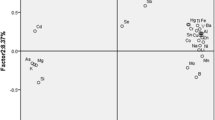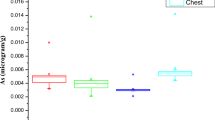Abstract
This study evaluated the bioaccumulation and biotransformation of arsenic species in chicken heart and meat tissues. The experimental study was carried out using two sets of samples. In the first one, 10-d-old chickens were exposed to sodium arsenate, using spiked drinking water. These chickens grew normally and were killed after 50 d of arsenic exposure. The second set were edible chickens used as blanks for a parallel study. The total arsenic and arsenic species content in the exposed samples were at least twice those in the normal edible chicken. It has been demonstrated that sodium arsenate is biotransformed to arsenite and an unknown species and its distribution varies among the different cardiac and meat tissues. One important aspect is the capability of the auricle to preconcentrate the most toxic species, arsenite, in the exposed chicken. A nonidentified arsenic species from the edible chicken was detected. Arsenobetaine was also detected in several tissues. This article shows that chicken can be used as a representative animal when considering inorganic arsenic exposure in humans.
Similar content being viewed by others
References
I. Herts-Picciotto, H. M. Arrighi, and S. W. Hu, Does arsenic exposure increase the risk for circulatory disease? Am. J. Epidemiol. 151, 174–181 (2000).
R. Zaldivar, L. Prunes, and G. Ghai, Arsenic dose in patients with cutaneous carcinomata and hepatic hemagio-endothelioma after environmental and occupational exposure, Arch. Toxicol. 47, 145–154 (1981).
US EPA, Drinking Water Regulations and Health Advisories, US Environmental Protection Agency, Health and Ecological Criteria Division, Washington, DC (1993).
C. Hopenhayn-Rich, S. Browning, I. Hertz, et al., Chronic arsenic exposure and risk of infant mortality in two areas of Chile, Environ. Health Perspect. 108, 667–673 (2000).
M. Wu, T. Kuo, and Y. Hanhwang, Dose-response relation between arsenic concentration in well water and mortality from cancers and vascular diseases, Am. J. Epidemiol. 130, 1123–1129 (1989).
US National Research Council, Arsenic in Drinking Water, National Academy Press, Washington DC, (1999).
C. O. Abernathy, Y. Liu, D. Longfellow, et al., Arsenic health effects mechanisms of actions, and research issues, Environ. Health Perspect. 107, 593–597 (1999).
C. Ferrecio, P. Gonzalez, S. Milosavjlevic, et al., Lung cancer and arsenic exposure in drinking water: a case-control study in Northern Chile, Saude Publica 14, 193–198 (1998).
I. Falnoga, V. Stibij, M. Tusek-Znidaric, et al., Effect of arsenic trioxide on metallothionein and its conversion to different arsenic metabolites in hen liver, J. Biol. Trace Element Res. 78, 241–254 (2000).
J. Centeno, F. Mullik, L. Martínez, et al., Pathology related to chronic arsenic exposure, Environ. Health Perspect. 110, 883–886 (2002).
F. Bertolero, E. Marafante, R. Pietra, et al., Biotransformation and intracellular binding of arsenic in tisúes of rabbits alfter intraperitoneal administration of As labelled arsenite, Toxicology 20, 35–44 (1981).
E. Marafante, M. Vahter, and J. Envia, The effects of methyltransferase inhibition on the metabolism of arsenite in mice and rabbits, Chem. Biol. Interact. 56, 225–238 (1985).
W. R. Cullen and E. H. Reimer, Arsenic speciation in the envirronment, Chem. Rev. 89, 713–764 (1989).
D. A. Bright, S. Brook, W. R. Cullen, et al., Methylation of arsenic by anaerobic microbial consortia isolated from lake sediment, Appl. Organomet. Chem. 8, 415–422 (1994).
M. A. Palacios, M. M. Gómez, C. Cámara, et al., Stability studies of arsenate, monomethylarsonate, dimethylarsinate, arsenobetaine and arsenocholine in deionized water, urine and clean-up dry residue from urine samples and determination by liquid chromatography, Anal. Chim. Acta 340, 209–220 (1997).
E. H. Larsen, G, Pritzl, and S. H. Hansen, Speciation of eight arsenic compounds in human urine by high-performance liquid chromatography with inductively coupled plasma mass spectrometric detection using antimonate for internal chromatographic standarization, J. Anal. Atom. Spectrom. 8, 557–563 (1996).
A. H. Smith, C. Hopenhayn-Rich, M. N. Bates, et al., Cancer risks from arsenic in drinking water Environ. Health Perspect. 97, 259–267 (1992).
J. P. Buchet, R. Lauwerys, and H. Roels, Urinary excretion of inorganic arsenic and its metabolites after repeated ingestion of sodium metaarsenite by volumeteers, Int. Arch. Occup. Environ. Health. 48, 111–118 (1981).
Y. Shibata and M. Morita, Characterization of organic arsenic compounds in bivalves, Appl. Organomet. Chem. 6, 340–343 (1992).
L. Benramdane, M. Accominotti, L. Fanton, et al., Arsenic speciation in human organs followins fatal arsenic trioxide poisoning—a case report, Clin. Chem. 45, 301–306 (1999).
M. Col, C. Col, A. Soran, et al., Arsenic related Bowen’s disease, palmar keratosis, and skin cancer, Environ. Health Perspect. 107, 687–689 (1999).
Author information
Authors and Affiliations
Rights and permissions
About this article
Cite this article
Pizarro, I., Gómez, M.M., Fodor, P. et al. Distribution and biotransformation of arsenic species in chicken cardiac and muscle tissues. Biol Trace Elem Res 99, 129–143 (2004). https://doi.org/10.1385/BTER:99:1-3:129
Received:
Revised:
Accepted:
Issue Date:
DOI: https://doi.org/10.1385/BTER:99:1-3:129




